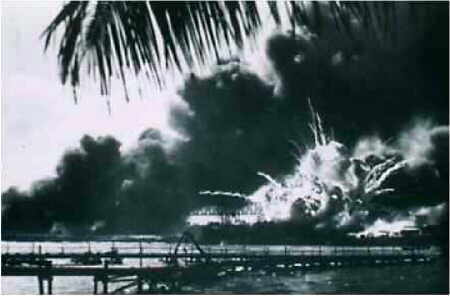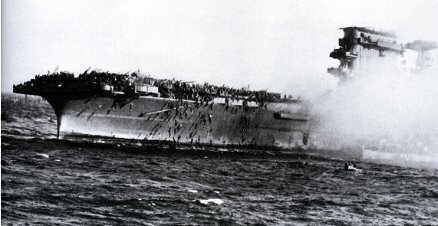
These pages give an overview of the early Pacific campaign, concentrating on the New Guinea/South Pacific area of operations. After all the many early defeats, the first allied victories in the long struggle to defeat Japan occured in this area. The rest of the Pacific campaign (Phillipines, Iwo Jima, Okinawa, etc) has been well documented elsewhere. The importance of these first victories has often been overlooked, but they were the begining of the end for the Japanese empire. The battles fought in the swamps and jungles of New Guinea were always fought in the worst conditions imaginable, they were also some of the most hard fought, bloody, disease ridden battles ever suffered by allied troops.

The magazine on the Destroyer USS Shaw explodes during the Jap sneak attack on Pearl Harbor. The ship stayed afloat, was repaired and went back into service
The Japanese declaration of war was delivered to the US secretary of state at around 2.15pm, Eastern time, December 7th, 1941. It added insult to injury because the Japanese attack on Pearl Harbor had been going on for nearly an hour! So began the 'day of infamy' it was to end with the awakening of the 'sleeping giant' & did indeed fill him with a 'Terrible resolve' that would ultimately lead to Japans utter defeat as foreseen by Admiral Yamamoto.
Wake Island, the Philippines, Singapore, Malaysia, all quickly fell to the Japanese Army. It seemed as if the Japanese were unstoppable, the much derided 'little yellow guys' had beaten everything the allies had in the Pacific. The 2 British Battleships, HMS Repulse and HMS Prince of Wales had been sunk at the cost of only 4 Japanese planes, the Dutch East Indies were taken and hundreds of thousands of British, American, Dutch, Filipino, Australian and Indian troops were taken prisoner, nearly half of whom would die under appalling conditions in Japanese prison camps or else were executed by fanatical 'Bushido' warriors. The Japanese now set their sights on New guinea, Australia and Midway Island. Shortly after Pearl Harbor, Lieut. Colonel James H Doolittle had started working on a plan to bomb the Japanese mainland. Knowing that using carrier based planes with their 300 mile range meant that the carrier that launched them would have to sail dangerously close to Japan and therefore be at risk of attack from Jap sea and air forces, Doolittle's plan called for land based B25s to be launched from a carrier at 700 miles from Japan, then , after dropping their bombs, to fly on to bases in Russia and China. On April 18th 1942, the heavily laden planes struggled into the sky from the deck of the carrier Hornet.

As Doolittle's plane fades to a speck in the distance, the second B25 lumbers into the air.
The Japanese had already detected Hornet but were waiting for her to come within the usual 300 mile range before launching any attacks, as they waited, Doolittle's 16 planes swooped in to drop their bombs on Tokyo and four other cities. None of the planes were lost to enemy fire and they headed off to China, where eight flyers were captured by the Japs after running out of fuel and bailing out over Japanese occupied territory, of the eight, three were executed by beheading, one died in prison and the others endured 40 months of terrible treatment at the hands of the Japs until the armistice secured their freedom. The other planes all made it to friendly territory except for one that chose to fly to Siberia instead of ditching in the sea off the coast of China, the crew and plane were promptly interned by the Russians who were not yet at war with the Axis powers. The Chinese were made to suffer dearly for assisting the 'American Air Pirates' as the Japs launched a three month reprisal campaign in which thousands of innocent Chinese were slaughtered and whole towns and villages were laid waste. Although little actual damage was done by the raid, it did raise American morale and put a dent in Japanese morale by proving that their islands were not invulnerable as the Japanese thought. The raid also had the effect of accelerating the Japanese plans to extend their defensive perimeter which in turn lead to their costly defeat at the Battle of Midway a few weeks later.
Before Midway however, the Battle of the Corral Sea would break the myth of Japanese invincibility. In early 1942, the Japanese sent an invasion force by sea to take the town of Port Moresby from the allies (who were building a base there). Rear Admiral Fletcher led a force of US and Australian ships (including the big carriers, Lexington & Yorktown) to block the force. After 'groping' through the fog and mist, the two opposing forces aircraft found each other, this was the first of the many sea/air battles that were a phenomenon of the Pacific, in which the opposing ships never saw each other! Although losses were about equal (Japanese-light carrier Shoho & a destroyer. Americans-a destroyer, an oiler & worst of all, the carrier Lexington) the battle proved that Japanese ships could be sunk and they would retreat if forced to.

The crew of the 'Lady Lex' abandon ship. She was so badly damaged that she had to be sunk by torpedoes from the destroyer Phelps.